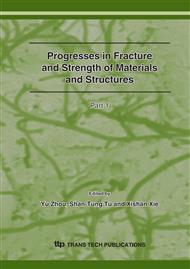p.1
p.9
p.19
p.24
p.28
p.34
p.38
p.42
p.46
Fatigue Damage Accumulation of Welded Bridge Member during Crack Growth Propagation with Initial Crack
Abstract:
The crack growth behavior and the fatigue life of welded members with initial crack in bridges under traffic loading were investigated. Based on existed fatigue experiment results of welded members with initial crack and the fatigue experiment result of welded bridge member under constant stress cycle, the crack keeps semi-elliptical shape with variable ratio of a/c during crack propagation. The calculated method of the stress intensity factor necessary for welded bridge member crack propagation was discussed. The crack remained semi-elliptical shape with variable ratio of a/c during crack propagation. The fatigue crack propagation law suitable for welded steel bridge member fatigue crack propagation analysis was deduced based on the continuum damage mechanics and fracture mechanics. The proposed fatigue crack growth model was then applied to calculate the crack growth and the fatigue life of existed welded member with fatigue experimental result. The calculated and measured fatigue life was generally in good agreement, at suitable initial conditions of cracking, for welded member widely used in steel bridges.
Info:
Periodical:
Pages:
24-27
Citation:
Online since:
September 2007
Authors:
Keywords:
Price:
Сopyright:
© 2007 Trans Tech Publications Ltd. All Rights Reserved
Share:
Citation:


